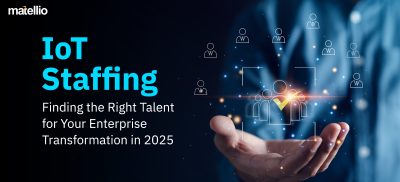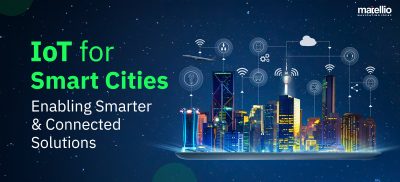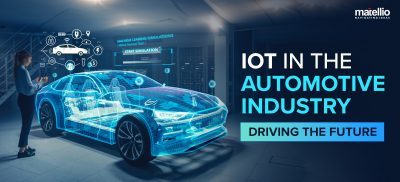
Internet of Things (IoT) has become one of the most sought-after and widely embraced technologies of recent years. IoT has allowed countless industries to reimagine how they do business, reach their target customers, and run their internal processes.
The impact IoT has had on major industries such as healthcare, media & entertainment can’t be overlooked. But what sets IoT apart is its appeal to the consumers.
IoT is not just a technology that helps businesses earn more revenue and run their companies more smoothly. No, IoT has been accepted by the consumers with open arms; from smartwatches to smart lights and speakers, the consumer market is chock-full of IoT-based devices that enhance our day-to-day lives.
Recent studies show that there are currently more than 7 billion IoT devices installed around the globe. And according to the stats posted by Statista, this number is likely to hit 30 billion by 2025. Furthermore, Deloitte projects that global IoT spending will cross the $1 trillion mark by the end of 2023.
The above stats make it apparent that the IoT revolution is finally reaching its maturity, and we can expect some great breakthroughs in the consumer and industrial markets in the coming years.
And with that in mind, IoT experts at Matellio have created the following list of top IoT trends that will lead the industry in 2022.
Top IoT Trends for 2025
1. IoT-based AI Models
IoT is one of the central technologies that help us build smart facilities. A smart facility is any commercial space where net-enabled devices communicate with each other over wired or wireless networks.
These devices vary in nature and utility widely. From temperature and motion sensors to automatic locks and CCTV cameras, there are countless IoT devices on the market that serve various purposes. These devices are connected with each other and the backend server and exchange data and commands in real-time.
The real-time data collected by these devices makes IoT a vital piece of any smart infrastructure. This data allows managers to monitor their facilities, workforce, and assets to increase efficiency and productivity.
But the problem with real-time data is that there is usually so much of it. Imagine hundreds of IoT devices streaming packets of data to the server every few seconds. It makes it impossible for humans to sift through all that data and make observations, reports, etc.
This is where AI models come in.
As you are probably already aware, AI models have to be trained with the help of a stupendous amount of data. It allows AI to analyze more branching scenarios, learn about a system’s behavior properly, and be ready for anything.
With the help of real-time data, AI models can provide critical observations such as trends, predictions, etc. For instance, imagine in an office, one room gets empty after five in the evening. The AI made this observation thanks to the CCTV camera footage and door locks. It studied countless data sets and finally came to this conclusion. Now, AI can provide this data to the managers, and they can put it to good use. For instance, if the room is empty after five in the evening, the HVAC systems can be turned off, thus saving electricity.
It is easy to see that AI models would have no data to work with without IoT. As more and more companies make the shift to smart facilities, IoT-based AI models and IoT consulting services will become only more popular.
2. IoT Software Development
Any IoT implementation has two components: hardware and software.
The hardware side can further be broken down into various sensors and devices installed to gather data of various kinds.
But hardware alone is insufficient.
While some level of automation and control liberty can be provided to IoT ecosystems (Edge devices), a software layer is essential for any functional IoT implementation.
The overall spending on IoT software grew about 30% last year, whereas IoT hardware spending only grew by 5%.
The reason for the growing interest in IoT software is very simple: hardware can gather the data; what happens with that data and how it is utilized depends on the users.
To access this data, users need neatly-designed and feature-rich IoT software platforms.
With the help of IoT software tools, managers and users can monitor device data as it is received in real-time. They also get various charts, projection reports, and detailed analyses about device health, utilization, etc.
A well-trained AI can take the benefits managers can get from their IoT software solutions even further. By analyzing the vast seas of real-time data, AI can predict device failures and downtimes, tell customer buying trends and employee behavior, and even tell the managers the best way to reach their target customers.
If you are looking to get IoT software for your business, you have a lot of choices.
You can get a custom IoT development solutions developed for your company. There are plenty of talented IoT development experts out there, like Matellio, who can help you design, develop, and deploy your IoT solution on time and under budget.
But if you don’t want the hassle of a legacy, on-premise solution, you can go for cloud-based IoT solutions such as AWS and Microsoft Azure.
The problem with IoT software development, especially in IoT in education, is that devices come from various vendors and thus work on different operating systems and have different management tools. For an IoT environment, these devices should be manageable from a single tool. A great solution to this predicament is Containerization. Containerization is OS-level virtualization over multiple network resources to allow software applications to run in clandestine user spaces called containers regardless of the device type or vendor. In the context of IoT in education, containerization ensures seamless integration and management of diverse educational IoT devices, enhancing scalability and security.
Containerized applications have become very popular among major enterprises. In fact, according to Gartner, about three-quarters of global enterprises will be using containerized applications by the end of 2022.
3. The IoMT Revolution
The COVID-19 pandemic led to swift and across-the-board digitization in many industries, including healthcare. Frequent and extended lockdowns forced people to stay confined to their homes, so they needed ways to get the medical attention they needed remotely.
As a direct result, the telehealth market saw unprecedented growth during the pandemic.
According to stats, the number of digital doctor visits climbed from 36 million at the start of 2020 to around 1 billion by the end of the year.
But this is more than just a sudden burst of popularity; it is a shift in how the healthcare industry works and how people now want healthcare services.
One of the biggest draws of telehealth is that it is remote. People don’t have to wait in lines to get appointments, only to have the doctor cancel the appointments. Furthermore, appointment booking has become significantly easier with the help of telehealth apps.
Remote healthcare is especially a blessing for people who reside in far-off places. Telehealth eliminated the need for them to drive for hours to get to their appointments.
Healthcare businesses quickly responded to this sudden shift in patients’ desires and needs and began investing heavily in digital healthcare solutions of their own.
According to stats, 84% of doctors say they provide telehealth solutions to their patients.
The rapid digitization of the healthcare industry also sped up the IoT revolution. Also called the Internet of Medical Things (IoMT), healthcare IoT has grown many folds in the last couple of years.
In 2015, there were around 4.5 billion IoMT devices, but by the end of 2020, there were about 20-30 billion IoMT devices. Furthermore, the IoMT industry is expected to be worth around $350 billion by the end of 2027.
Benefits of IoMT
IoMT has many benefits for the healthcare industry. Remote monitoring has become significantly more streamlined in recent years, thanks to the sophistication of IoMT solutions.
Patients who can’t travel for their check-ups due to their health or opt for remote care can now receive top-notch healthcare services thanks to IoMT. Doctors and healthcare providers can remotely monitor the health of the patient. And an AI model can help them predict health-related complications.
On the less dire side, wearable devices such as smartwatches help doctors and at-risk patients be in constant sync. Wearable devices have all manners of scanners like heart rate monitors and ECG sensors, and doctors can monitor their patients’ vitals as they do their business.
IoMT also streamlines how hospitals and clinics operate. It allows managers to automate repetitive tasks, manage their assets, and optimize workforce utilization.
In the past few years, some major leaps have been made in the IoMT industry, and we expect this trend to continue as healthcare providers try to bring their services to the patients in an improved and streamlined fashion.
Read More: Explore the transformative impact of IoT-enabled smart lighting systems for smart cities, enhancing energy efficiency, reducing costs, and improving public safety.
4. The IIoT Revolution
The Industrial Internet of Things, or IIoT, has completely changed how the manufacturing and logistics industries operate.
Big manufacturers have many factories in different parts of the world. These factories generate a tremendous amount of product, chew through an astonishing reserve of raw material, and cause an alarming level of damage to the environment daily. Incorporating IoT product development can help optimize operations, reduce waste, and mitigate environmental impact.
However, with the help of IIoT, they can make their factories more efficient, productive, and environment friendly.
Asset management and maintenance are two of the biggest challenges for big factories.
The ecosystem inside a factory contains countless machines, big and small. And if even a single machine breaks down, then the production suffers. IIoT can help managers repair their machines before they break down. It’s called predictive maintenance, and IoT and AI are its two key parts.
Workforce optimization is also essential for any factory to work efficiently. Obviously, you can’t automate everything in a factory, but tasks that don’t require human cognitive skills can be done by robots and AI. This frees up your workforce to do other, more cognitively taxing tasks.
The environmental impact of manufacturing is well documented and apparent to everybody. The harmful substances released into our environment by the factories cause irreparable damage to our atmosphere, flora, fauna, and water sources.
But most companies nowadays go the extra mile and try to minimize their environmental impact. This includes the installation of various purifiers, sensors, etc.
Most companies take their green initiatives very seriously, and many governments also provide some concessions to the companies that follow the nation’s environmental guidelines.
Conclusion
IoT has been around for a long time and is quickly becoming an essential part of our work and personal lives. Seamless connectivity between various devices allows companies to automate repetitive tasks, improve efficiency, and enhance productivity. At the same time, consumer devices such as smart speakers, motion sensor lights, and wearable devices make the life of consumers a lot easier.
If you are looking to hire IoT developer and consultant, then look no further! Matellio has years of experience crafting flawless IoT ecosystems backed by sound software layers for various industries. With the help of the Agile software development methodology, we offer top-notch and scalable services to businesses of different sizes.




